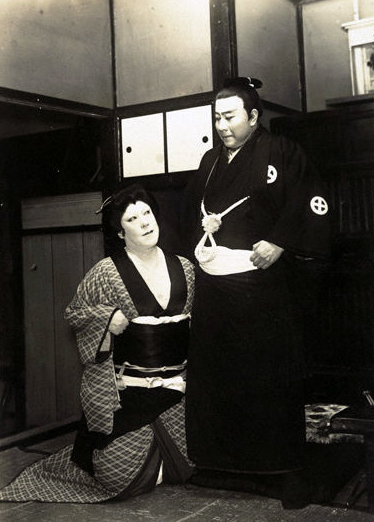| SAIGď TO BUTA-HIME |
| Play title | Saig˘ to Buta-hime |
| Author | Ikeda Daigo |
| History |
Ikeda Daigo's drama "Saig˘ to Buta-hime" was premiered in May 1917 at the Yűrakuza with a non-Kabuki troupe named Mumeikai. It was staged for the first time with Kabuki actors in November 1924 at the H˘rakuza (T˘ky˘), starring Jitsukawa Enjaku II and Kataoka Ichiz˘ IV in the roles of Otama and Saig˘ Kichinosuke. It was staged for the first time in ˘shibai in May 1933 at the Meijiza [more details]. |
| Structure |
The current version of "Saig˘ to Buta-hime" is made up of 1 act (1 scene). |
| Key words |
Bakumatsu Bakumatsumono Daimy˘ Geigi Hanamachi Ishin no Sanketsu Kirino Toshiaki Maiko Meiji Ishin Nakai Nakamura Hanjir˘ ďkubo Ichisuke ďkubo Toshimichi Saig˘ Kichinosuke Saig˘ Takamori Sanbongi Satsuma-han Shinjű Shinkabuki Tesaki |
| Summary |
In the hanamachi of Sanbongi, one of the pleasure quarters of Ky˘to, dusk is falling. An ageya is bustling with activity as evening draws near. In spite of the outward cheerful atmosphere, there is some restlessness in the air. Even the nakai and geigi talk turns to rumors of the samurai that are plotting to overthrow the Tokugawa Shogunate and re-establish the Imperial power. After decades of peace and prosperity, the country has passed into a decadent age and the seeds of the coming revolution have already been sown. The nakai Otama enters the room. She is both graceless and quite ugly, which may explains that her nickname is Buta-Hime, literally 'Princess Pig". She is unhappy because the man whom she loves, a young samurai from the Satsuma Domain named Saig˘ Kichinosuke who is in favor of the imperial restoration, has lost the favor of his daimy˘ and is now in partial retirement. The maiko Hinayű enters and cries, seeking comfort from Otama for her own unhappy love affair. Otama tries to be as merry as possible through her voice and words of comfort, but the two women are all the same underneath the top layer in their sad life. As Otama is left alone again, Saig˘ unexpectedly enters the room. At almost the same time, someone knocks frantically on the back gate of the ageya. It is Saig˘'s follower Nakamura Hanjir˘, who is fleeing from the officials for having slayed one of Saig˘'s pursuers. Aided by Otama, Nakamura flees by another door as the tesaki enter the house, while Saig˘ hides in another room. The pursuers try to force Otama to reveal the whereabouts of the revolutionists. Saig˘ suddenly appears from the inner room. Because of Saig˘'s big-voiced anger, the pursuers slink away. Saig˘ tells Otama he is hungry so she leaves to prepare some food for him, while Saig˘ goes behind a screen and falls asleep there. Meanwhile some maiko come to the room for a dancing lesson, but are startled by the huge snorts that come from behind the screen. They do not know that it is Saig˘ snoring there and break into an excited commotion, until Otama enters the room and shoos them away. She shakes Saig˘ awake, and as the two face each other, Saig˘ is struck by the simple innocence of this nakai and her sincerity in her attitude toward him. Saig˘, himself a simple-hearted man, sympathizes with her lonely fate, and the two cry like children. As Saig˘ is himself at the bottom of despair because of the seeming hopelessness of carrying out a successful revolution, he and Otama decide to commit shinjű tonight. To be able to die with Saig˘ being Otama's highest possible form of happiness, she sheds tears of joy as she stands to open the windows wide. The wind blows the light out and moonlight pours into the room. Suddenly, ďkubo Ichisuke and another follower of Saig˘ dash in. They bring tidings that Saig˘'s dream has come true. His daimy˘ has reinstated him, and they are to depart for Edo at once. The time for the revolution and Saig˘'s days have come. All thoughts of committing suicide leave him at once. Saig˘'s good fortune is also a source of happiness for Otama but she knows that his success means the end of her relationship with him. He will leave for higher glory and she will be the one left behind. As she stands, lost in tears, Saig˘ Kichinosuke takes the coins handed him by his followers. Keeping only one ry˘ for himself, he forces the rest of the money into Otama's hands, and he departs, face glowing with a new hope for his country. Otama watches him leave, knowing that it will never be the same again for her. |
| Trivia |
Matsumoto K˘shir˘ VIII and Nakamura Kanzabur˘ XVII in the roles of Saig˘ and Otama made a goruden konbi. |
 |
|
The actors Jitsukawa Enjaku II (left) and Matsumoto K˘shir˘ VII (right) playing the roles of the nakai Otama and Saig˘ Kichinosuke in the drama "Saig˘ to Buta-hime", which was staged in May 1933 at the Meijiza |
|
|
| Contact | Main | Top | Updates | Actors | Plays | Playwrights | Programs | Links | FAQ | Glossary | Chronology | Illustrations | Prints | Characters | Derivatives | Theaters | Coming soon | News |